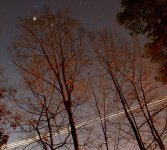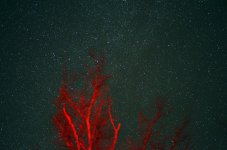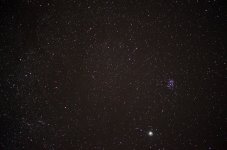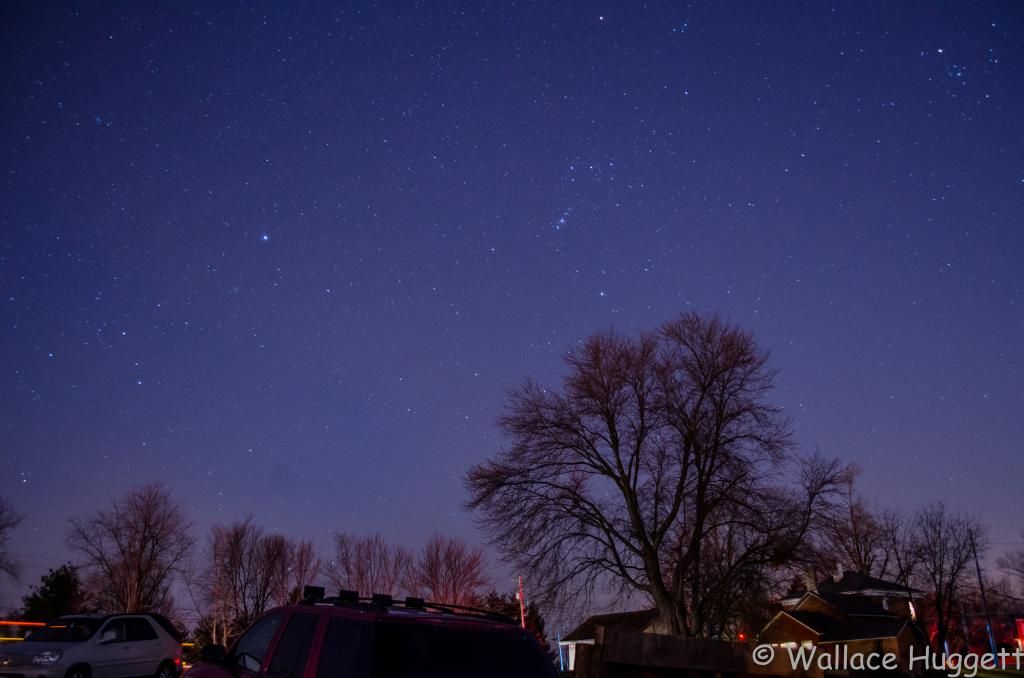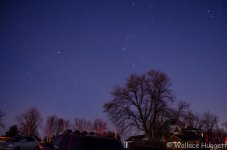You are using an out of date browser. It may not display this or other websites correctly.
You should upgrade or use an alternative browser.
You should upgrade or use an alternative browser.
Star Photography One on One
- Thread starter Wahugg
- Start date
sailtastic
Senior Member
My shots were taken on my D3100, with 18-55mm kit lens.
I set everything to manual and ran at as low an ISO as I dared.
I set everything to manual and ran at as low an ISO as I dared.
My first attempt at star photography... used my D7000.
I had a few issues here, I think.
- too much external light (was outside of my house... there was a porch light on and the street light)
- too low ISO, too long a shutter release - was 2 min or so
- no exposure delay mode used
- possibly a bad focus job
Anyone using the VR option? I've read that it should be set to off for night photos.
Looking forward to the next time I can get out away from the city and all the light pollution to play with this more.
The one cool thing was that the light streak was a passing plane.
I had a few issues here, I think.
- too much external light (was outside of my house... there was a porch light on and the street light)
- too low ISO, too long a shutter release - was 2 min or so
- no exposure delay mode used
- possibly a bad focus job
Anyone using the VR option? I've read that it should be set to off for night photos.
Looking forward to the next time I can get out away from the city and all the light pollution to play with this more.
The one cool thing was that the light streak was a passing plane.
Attachments
sailtastic
Senior Member
JPar,
It depends on what you were trying to get in focus. It looks like you've done a good job of focussing on the trees rather than the stars.
As for light sources, sometimes they add an interesting twist to the pics, so not all bad but if you want pure star shots then best to find somewhere with little light interference.
The aircraft light streak looks great.
As for VR, I'm not really sure, but I heard that it was best to turn it off, so thats what I did! I haven't tried with it on to see what difference it would make.
Paul
It depends on what you were trying to get in focus. It looks like you've done a good job of focussing on the trees rather than the stars.
As for light sources, sometimes they add an interesting twist to the pics, so not all bad but if you want pure star shots then best to find somewhere with little light interference.
The aircraft light streak looks great.
As for VR, I'm not really sure, but I heard that it was best to turn it off, so thats what I did! I haven't tried with it on to see what difference it would make.
Paul
Great shots guys! It really thrills me seeing other people go out and enjoy the night sky too!
As for leaving the VR off in layman's terms: It will actually cause wobble if the camera is properly mounted on a non-moving surface such as a tripod. It's a very similar situation to AF not working properly at night, except substitute VR and tripods in for AF and night time.
I quickly stitched together a time-lapse of tonight while working on my Trailblazer. The video is in the link below (sorry, no hd guys as this was a very quick edit for this post), and it is extremely important that you full screen the video to fully see the VR wobble. Right around 4 seconds where I leave the shop floor, you can see the image frame shifting or moving as if the camera is wobbling. In reality the camera is on a very sturdy tripod, but the VR is messing up causing wobbles. At around 9 seconds this all stops because I turned VR off.
Video: https://vimeo.com/54820344
(FULL SCREEN IT)
Now keep in mind this took place over 100's of photos, so it's a bit extreme. However, since we are using exposure times of 20-30+ seconds (Compared to >1 second exposures of the photos in the video) wobbling will be amplified a hundred fold in a single shot. This can cause the photo to look as if it were soft focused, or can even cause noticible, non-natural streaks or movements of the stars.
I hope this clears up the VR confusion
Happy shooting!
-Wahugg
EDIT: Also note the main article has been re written to some degree, and will probably see further editing from me later tonight.
As for leaving the VR off in layman's terms: It will actually cause wobble if the camera is properly mounted on a non-moving surface such as a tripod. It's a very similar situation to AF not working properly at night, except substitute VR and tripods in for AF and night time.
I quickly stitched together a time-lapse of tonight while working on my Trailblazer. The video is in the link below (sorry, no hd guys as this was a very quick edit for this post), and it is extremely important that you full screen the video to fully see the VR wobble. Right around 4 seconds where I leave the shop floor, you can see the image frame shifting or moving as if the camera is wobbling. In reality the camera is on a very sturdy tripod, but the VR is messing up causing wobbles. At around 9 seconds this all stops because I turned VR off.
Video: https://vimeo.com/54820344
(FULL SCREEN IT)
Now keep in mind this took place over 100's of photos, so it's a bit extreme. However, since we are using exposure times of 20-30+ seconds (Compared to >1 second exposures of the photos in the video) wobbling will be amplified a hundred fold in a single shot. This can cause the photo to look as if it were soft focused, or can even cause noticible, non-natural streaks or movements of the stars.
I hope this clears up the VR confusion
Happy shooting!
-Wahugg
EDIT: Also note the main article has been re written to some degree, and will probably see further editing from me later tonight.
Last edited:
I completely missed this thread when it first got posted. It was during one of my times of illness and I wasn't doing much. Really good info Wahugg. I saw it last night and it made me rush out and shoot some star photos. When I got outside, it was cold and I remembered... I really hate cold so I went back in. I'll have to try and do this when it warms up.
Hey all!
It's been a while since I have really been out shooting photos due to schooling, work, and family. But I went out last night and was able to grab a couple shots!
-------------------------------------

-------------------------------------

-------------------------------------

-------------------------------------
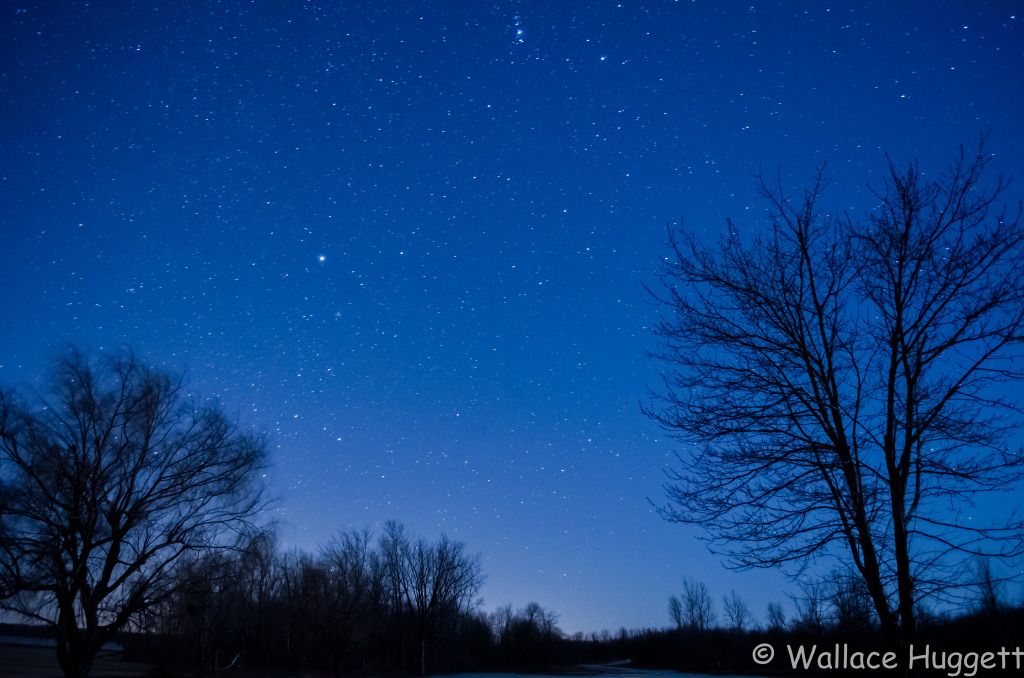
-------------------------------------
Most of these were shot using the following EXIF
ISO: 3200
Aperture: f3.5
Focal Length: 18mm
Exposure time: 30 seconds
But remember, I did not get these shots by just using those settings. I had to do editing in lightroom4 to achieve those results. If your interested in bringing the quality of your night shots to the next level, you should seriously consider getting lightroom. At the very least it has a 30 day FULL trial so you can decide if you want it or not. Also, you can buy it at a heavily discounted price if your a student. Or you could buy it for you child who is in school to achieve the discount and use it when they aren't using the computer.
Happy Shooting!
-Wahugg
It's been a while since I have really been out shooting photos due to schooling, work, and family. But I went out last night and was able to grab a couple shots!
-------------------------------------

-------------------------------------

-------------------------------------

-------------------------------------

-------------------------------------
Most of these were shot using the following EXIF
ISO: 3200
Aperture: f3.5
Focal Length: 18mm
Exposure time: 30 seconds
But remember, I did not get these shots by just using those settings. I had to do editing in lightroom4 to achieve those results. If your interested in bringing the quality of your night shots to the next level, you should seriously consider getting lightroom. At the very least it has a 30 day FULL trial so you can decide if you want it or not. Also, you can buy it at a heavily discounted price if your a student. Or you could buy it for you child who is in school to achieve the discount and use it when they aren't using the computer.
Happy Shooting!
-Wahugg
Last edited:
Here are a couple of my first attempts. I tried higher ISOs, but there was too much light pollution and it really showed. So ISO 1ooo, f/4 and 59 seconds. Taken with an old 24 mm so tht would put it about a 27 mm, right? It has been freakin' cold and cloudy almost every day so... As you can see, I used too much time and started to get star trails.
https://sphotos-b.xx.fbcdn.net/hphotos-ash4/740407_534855276524980_891952252_o.jpg
What type of editing are you talking about?keep in mind, editing go a long way with night shots.
https://sphotos-b.xx.fbcdn.net/hphotos-ash4/740407_534855276524980_891952252_o.jpg
O Here is one of my first attemps. ISO is 1000, 24 mm old lens so ~27mm, f/4, 59 secs (obviously too long!). I tried ISO 3200, but there was too much light pollution.
keep in mind, editing go a long way with night shots. What do you mean by this?
https://sphotos-b.xx.fbcdn.net/hphotos-ash4/740407_534855276524980_891952252_o.jpg
This is one of my first attempts. ISO 1000, 24mm old lens ~27mm, f/4, 59 seconds (obviously too long!) What do you mean by editing? I tried using ISO 3200, but there was too much light pollution.
https://sphotos-b.xx.fbcdn.net/hphotos-ash4/740407_534855276524980_891952252_o.jpg
https://sphotos-b.xx.fbcdn.net/hphotos-ash4/740407_534855276524980_891952252_o.jpg
Ive just had my first attempt at star photography, i was using a 30 second exposure, looking at the pictures close up on my computer, most of the stars seems to have a trail. Now I know that you can shoot star trails by using very long exposure / stacking images, but is it possible that in just 30 second the earth is rotating enough to show small trails on the stars?!
It's absolutely possible to see star trails within 30 seconds.
Here is the general rule of thumb:
For FX sensors: 600/focal length = expose time when star trails begin to get noticeable ex: 600/30mm= 20 seconds
For DX sensors: 400/focal length = expose time when star trails begin to get noticeable ex: 400/30mm= 13.3 seconds
Hope this helps
-Wahugg
Here is the general rule of thumb:
For FX sensors: 600/focal length = expose time when star trails begin to get noticeable ex: 600/30mm= 20 seconds
For DX sensors: 400/focal length = expose time when star trails begin to get noticeable ex: 400/30mm= 13.3 seconds
Hope this helps
-Wahugg

